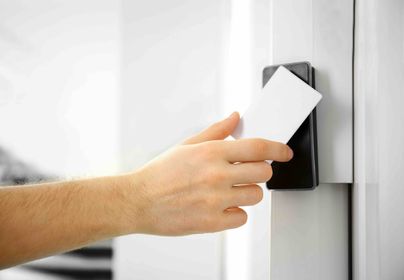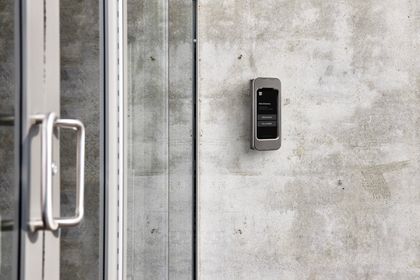Facial recognition access control has been on the market for the past 5 years, but there are major drawbacks to these systems that still leave many people concerned about the safety and security of using face recognition. The biggest limitations include lack of accuracy, spoofing issues, and difficult operating systems.
At Swiftlane, we have overcome these limitations, while creating the most advanced, touchless access control experience.
This article covers those limitations of face recognition access control and showcases how Swiftlane’s cutting-edge technology is tackling many of these issues.
Table of contents
- Video Surveillance Cameras and Face Recognition
- Facial Recognition Readers
- Enterprise Facial Recognition Systems
- How Swiftlane Overcomes Facial Recognition Limitations
Also, read
- How Facial Recognition Works
- Best Face Recognition Door Locks
- Face Recognition Access Control Systems
- 3 Privacy Concerns Around Facial Recognition Technology
Video Surveillance Cameras and Face Recognition
- Video surveillance cameras are typically designed to capture maximum field of view. So an HD camera might cover a 180 degree swath in front of the camera for maximum coverage. But this wide scope reduces the overall pixel density in any given area, like the pixels that make up a person’s face. That yields a lower resolution face image and poor recognition accuracy.
- Video surveillance cameras do not provide 3D face check. Someone could hold a photo of a person in front of a camera and trick the system into believing it’s the actual person. Called spoofing, this method is easy to do with a large photo of an authorized person.
- Video surveillance cameras are typically mounted in the corner of a room. The distance from people results in poor face recognition. accuracy. In addition, it is inconvenient for a user to turn their head to look up at a ceiling, and it poses a trip-and-fall hazard.
- Video surveillance systems are not designed for access control. They lack all the important access management features that typically are needed for proper access management.
Facial Recognition Readers
There are many standalone readers that lack proper access control functions. These standalone readers provide enrollment, face recognition, and a door release system. These interfaces are typically poorly made and are siloed from the overall building and security operation, thus making them difficult to use.
- Chinese products raise acute privacy risks. The U.S. government has banned Chinese systems from Dahua and Hikvision. The Chinese government harnesses these systems for mass surveillance of Chinese citizens.
- Because of bans, organizations that use Chinese systems run risks of legal sanctions. With these systems under continued scrutiny by governments, investing heavily in them isn’t wise.
- Most Chinese face terminals only come as a standalone terminal and do not provide a comprehensive access management functionality around it.
- These products do not provide an access management system. All tasks must be done at each reader, including enrolling users, removing users, and changing permissions. With 10 doors, you would need to add each user to every door, which creates a logistical nightmare. There is no ability to remotely update permissions for users, which means it’s difficult to remove access for terminated staff.
- These systems are expensive — about $10,000 each without any corresponding software or integrations.
- Product manuals and information are in Chinese only.
- There are no support options. If something breaks you are on your own.
Enterprise Facial Recognition Systems
Companies such as Idemia and Bioconnect offer face recognition terminals that are more advanced than the Chinese products.
- These are designed for large implementations, such as government projects at border checkpoints, top financial institutions, and massive telecom build-outs.
- Each of these devices costs anywhere between $10000-$20000 per reader, which limits their use in most mid-sized businesses. A small office with 10 doors might run $150,000 in reader costs alone!
- Idemia and Suprema devices require heavy customization and engineering development, since they are typically used in very large projects with multimillion-dollar budgets.
- The hardware and software are typically developed by different companies. For instance, Bioconnect purchases its hardware from Suprema and builds its own software offering on top. This means there are three different vendors: face recognition hardware, face recognition software and the main access control software that all need to be integrated together. This increases the complexity of the system and also increases the deployment cost as well as technical training costs for running these systems.
- Onboarding people in these system can be challenging. Enrollment entails staff lining up at the doors, It is both logistically difficult and challenging during a pandemic.
- These biometric systems do not offer cloud based access control. They contain all the limitations and drawbacks of on-premise systems.
- Multisite support is not available. Users need to deploy completely disconnected systems across multiple buildings, or even across multiple floors. This severely limits the number and quality of applications. Overcoming this limitation requires assigning IT resources to ensure cross-office VPN across all company facilities and staff home offices. That expense dwarfs the expense of system installation.
How Swiftlane Overcomes Facial Recognition Limitations
Swiftlane overcomes the limitations of face recognition through a unique approach to access control.
Privacy
Swiftlane believes in a positive worldview toward the future of access control, built for privacy with end-to-end data encryption from all devices. Data is stored securely in our cloud based system. Swiftlane is SOC II certified; we take your data privacy and security very seriously.
Constantly Adapting AI System
Unlike most facial recognition products, Swiftlane’s system learns and improves every time you use it. For example, if someone grows facial hair, gains or loses weight, or applies more or less makeup, the system constantly learns and adjusts to the changes in the appearance over time. Just had a complete face makeover? Simply use the Swiftlane app to re-scan your face to update your profile in seconds.
Full Cloud Based Solution
Swiftlane provides a complete cloud-based access control system, not just a “face reader.” Instead of working with loosely connected hardware and software systems, you receive an integrated offering. Swiftlane cloud access control makes management of your system simple and streamlined.
2D and 3D Face Checks
Swiftlane access control isn’t fooled by any adversary displaying a photo or video of an enrolled user. It uses a 3D sensor to check the shape of the face and liveness of a person at the reader. Many other systems are vulnerable to this type of spoof attack.
Fastest Enrollment Process in the Industry
Users can enroll from anywhere in a minute or less using the Swiftlane mobile app. There’s no need to line up employees in front of a reader or pass out credentials.
Seamless Face Scan Experience
SwiftReaders mount at a 5 feet high and cover people from 4’ 3” to 6’ 5” without requiring them to bend, stand on their tiptoes, or crane their neck. Simply walk up to a SwiftReader, look at the device, and the door unlocks in seconds.
4MP Camera
Swiftlane’s 4MP camera ensures high pixel count and image density, yielding high-resolution images.
Multi Modal Authentication
Swiftlane combines two forms of touchless access into its readers: face and mobile phone. The two can be combined for higher security two-factor authentication.
Face Recognition Fallback
Have a small percentage of users who simply don’t want to use facial recognition? No worries. At Swiftlane, we respect your privacy choices. Swiftlane’s reader combines mobile app and face unlock. So users can use mobile app access control via the Swiftlane app, instead of using face recognition. Swiftlane also comes with PIN based unlock to provide “unique”, not shared PINs, to your users.
ADA Compliance
Because Swiftlane comes with built-in support for mobile based access via its app, you don’t need a separate key card system to comply with the ADA. A person in a wheelchair, for instance, can use the app for a touchless and ADA-compliant access control experience.
Customer Service and Continuing Innovation
At Swiftlane, we care about building a delightful product experience. We are constantly improving our installation, management and end user access control processes, via over-the-air updates and a constant feedback loop with our customers. You can rest assured that you are receiving the highest level of security and customer care.





